NASA APOD #522-529
#522 Fliers Around the Blue Snowball Nebula
Credit: November 22, 1996
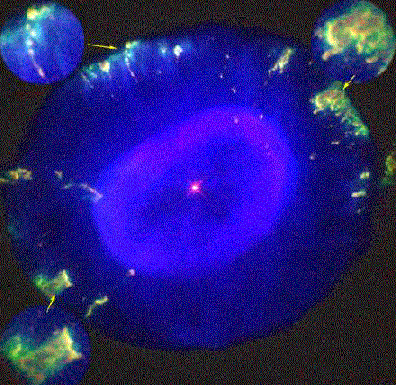
“Planetary nebulae are strange. First, they are gas clouds and have nothing to do with our Solar System's planets. Next, although hundreds of planetary nebulae have been catalogued and thousands surely exist in our Galaxy, aspects of the formation process are still debated. But now yet another mystery has come to light: what created the fast-moving gas clouds that appear around planetary nebula? Dubbed FLIERs for Fast Low-Ionization Emission Regions, these knots of dense gas appear to have been ejected from the central star before it cast of the planetary nebula. Currently, no model can account for either their formation or longevity. In the above false-color picture of NGC 7662, the Blue Snowball Planetary Nebula, the FLIERs are featured in the image inserts. "
Copyright: Public domain
#523 Gamma Ray Bursts from the Unknown
Credit: November 23, 1996
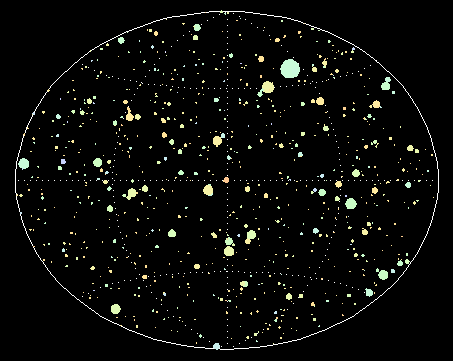
“Gamma Ray Bursts (GRBs) pose one of the greatest mysteries of modern astronomy. About once a day, the gamma-ray sky lights up with a spectacular explosion. No one knows what causes these explosions or even how far away they are. The above map represents the entire sky in coordinates centered on our Galaxy, the Milky Way. It shows the positions of over 800 of these mysterious bursts of energy detected by the BATSE instrument on board NASA's Compton Gamma Ray Observatory. Before BATSE, most astronomers thought that most GRBs occurred in the disk of our Galaxy, but the above sky map shows little sign of this. The distance scale of GRBs was the topic of a historic debate in April 1995. The positions in the above map are currently being studied in great detail in an effort to uncover a clue about the nature of GRBs. In the above 3B map created by R. Nemiroff, spot size is proportional to peak flux and spot color is indicative of hardness. "
Copyright: Public domain
#524 Apollo 12 Visits Surveyor 3
Credit: November 24, 1996
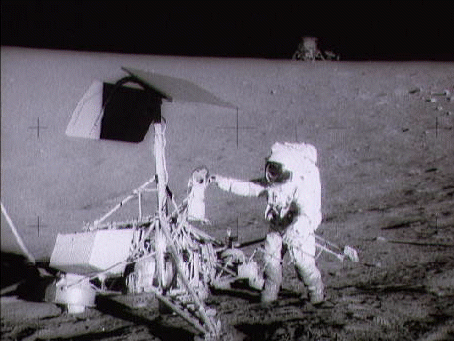
“Apollo 12 was the second mission to land humans on the Moon. The landing site was picked to be near the location of Surveyor 3, a robot spacecraft that had landed on the moon three years earlier. Pictured above, Apollo 12 astronauts Conrad and Bean retrieve parts from the Surveyor. The Lunar Module is visible in the distance. Apollo 12 brought back many photographs and moon rocks. Among the milestones made by Apollo 12 was the deployment of the Apollo Lunar Surface Experiments Package, which carried out many experiments including one that measured the solar wind."
Copyright: Public domain
#525 A Quasar Portrait Gallery
Credit: November 25, 1996
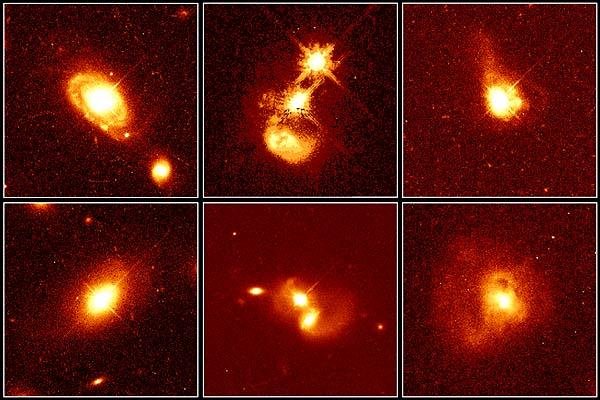
“QUASARs (QUASi-stellAR objects) lie near the edge of the observable Universe. Discovered in 1963, astronomers were astounded - to be visible at such extreme distances of billions of light-years they must emit prodigious amounts of energy. Where does the energy come from? Many believe the quasar's central engine is a giant black hole fueled by tremendous amounts of infalling gas, dust, and stars. This recently released gallery of quasar portraits from the Hubble Space Telescope offers a look at their local neighborhoods: the quasars themselves appear as the bright star-like objects with diffraction spikes. The images in the center and right hand columns reveal quasars associated with disrupted colliding and merging galaxies which should provide plenty of debris to feed a hungry black hole. Yet, in the left hand column a quasar is seen at the center of an otherwise normal looking spiral (above) and elliptical galaxy. Whatever the secret of the quasar's energy, all these sites must provide fuel for its central engine."
Copyright: Public domain
#526 The Radio Sky: Tuned to 408MHz
Credit: November 26, 1996
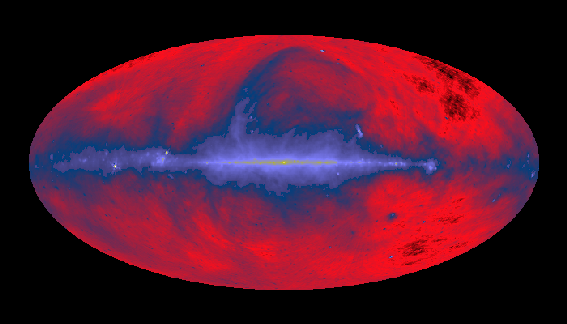
“Tune your radio telescope to 408MHz (408 million cycles per second) and check out the Radio Sky! You should find that frequency on your dial somewhere between US broadcast television channels 13 and 14. In the 1970s large dish antennas at three radio observatories, Jodrell Bank, MPIfR, and Parkes Observatory, were used to do just that - the data were combined to map the entire sky. Near this frequency, cosmic radio waves are generated by high energy electrons spiraling along magnetic fields. In the resulting false color image, the galactic plane runs horizontally through the center, but no stars are visible. Instead, many of the bright sources near the plane are distant pulsars, star forming regions, and supernova remnants, while the grand looping structures are pieces of bubbles blown by local stellar activity. External galaxies like Centaurus A, located above the plane to the right of center, and the LMC (below and right) also shine in the radio sky."
Copyright: Public domain
#527 Storm Clouds Over Jupiter
Credit: November 27, 1996
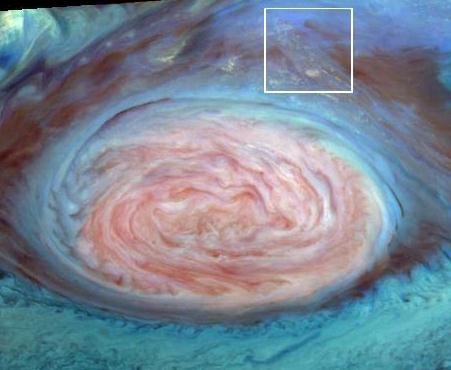
“Storm clouds, similar to the familiar cumulonimbus thunderheads of Earth, appear to be present on Jupiter. The mosaic of images above shows the region near the raging edge of Jupiter's Great Red Spot, itself some 2 to 3 Earths wide, as observed by the Galileo spacecraft in June of this year. The false colors represent altitude. Low altitude clouds are blue, high, thick clouds are white and high, thin clouds are pink, with the box at the upper right containing the high cloud features likened to the storm clouds of Earth. Scientists speculate that these features are evidence for an abundance of water in at least some regions of Jupiter's atmosphere. On Earth, atmospheric water vapor plays an important role in driving winds - this could well be true on Jupiter, where winds reach up to 300 miles per hour."
Copyright: Public domain
#528 Comet-like Clouds in the Cartwheel Galaxy
Credit: November 28, 1996
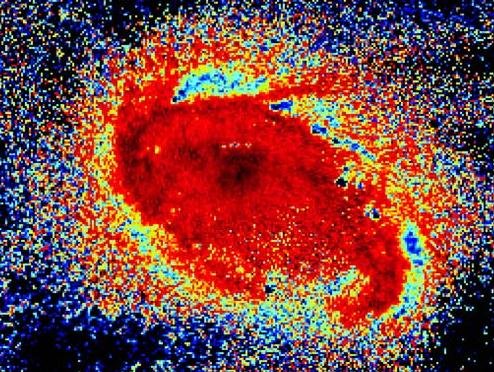
“In a cartwheel-shaped galaxy far, far away, huge comet-shaped clouds of gas have been discovered racing through the nucleus at about 700,000 miles per hour. The aptly named Cartwheel Galaxy is actually about 500 million light years distant, its suggestive shape created by a head-on collision with a smaller galaxy. Researchers studying this disrupted galaxy using Hubble Space Telescope data recently discovered immense gaseous structures with heads a few hundred light years across and tails thousands of light years long. The fast moving dense gas clouds appear as blue comet-like shapes, mostly along the upper edge of the nucleus, in this false color close-up of the Cartwheel's central region. Their shape, like a boat's bow wave, was probably created by the dense clouds moving through less dense material."
Copyright: Public domain
#529 Io: The Fissure King?
Credit: November 29, 1996
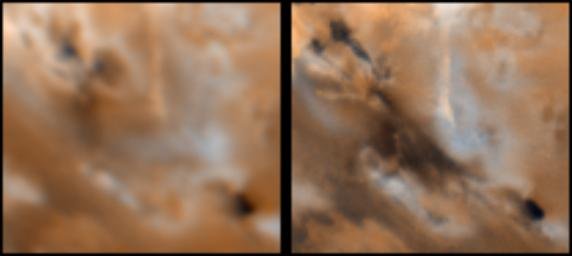
“Is Io the solar system's Fissure King? Well, probably not ... but it is the most active volcanic moon. Active volcanoes on Jupiter's moon Io were a surprise discovery of the Voyager missions of the late 1970s. The extent of Io's volcanic activity today is being investigated close-up by the Galileo spacecraft currently exploring the Jovian system. The two frames above show a roughly 300 mile square area around the Io volcano called Marduk. The left-hand view of Marduk was made by Voyager in 1979, the right-hand view by Galileo earlier this year. A comparison reveals that dramatic changes have occured, including the creation of a dark, linear feature running diagonally through the Galileo image that is probably a huge volcanic fissure."
Copyright: Public domain
Upvote! Resteem! Comment! As you like it! Thank you for attention!